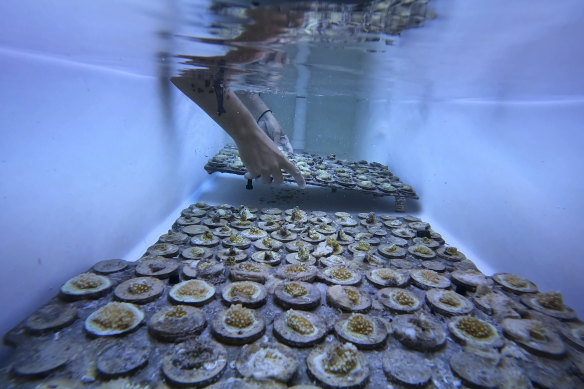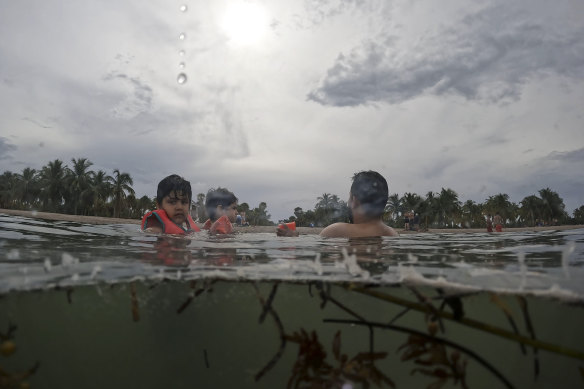
“It would feel,” Mullins said, “like you are swimming in soup.”
Ice blocks for the pool?
People already tend not to swim that much in the Florida waters that were so extremely hot last week. The water can get muddy and there are alligators and crocodiles in the area, too.
But high temperatures anywhere can make swimming less pleasant. Up to Friday, Phoenix endured highs above 43 degrees every day this month. Pools are warm. About 240 kilometres to the northwest in Lake Havasu City, Arizona, Stefanee Lynn Thompson, 50, wanted to keep guests cool for a pool party she hosted on Sunday. The heat had raised the pool’s temperature to 36 degrees.
Her friend recommended she buy ice blocks. She ran to the grocery store, picked up 40 of them and dumped them in the pool. She set up fans, too. All that hard work dropped the pool’s temperature a grand total of 2.2 degrees Celsius.
“When it’s 120 out, anything helps,” Thompson said.
Recently, ocean temperatures off the western coast of Florida have been a few degrees above normal, sitting at about 31-32 degrees. It’s not just humans that suffer when the oceans warm. Sea corals are bleaching. They can be hurt when water temperatures rise above the upper 80s (low 30 degrees Celsius).

A research associate places a tray of baby coral brought in from the University of Miami’s open water coral nurseries into a tank as staff and students work to save as much coral as the Lirman coral lab can hold on Friday.Credit: AP
July has been so hot that scientists announced a global heat record even before the month ended. Climate change is creating a hotter world, warming oceans and making some storms more destructive. Sea surface temperatures are somewhat above average around Florida, but they are far higher in parts of the North Atlantic near Newfoundland where they are as much as 5 degrees Celsius hotter than usual.
The extremely high sea surface temperatures recorded earlier this week off Florida’s southern tip were caused by lots of sun, little wind and no storms.
“I’ve never seen temperatures 100 degrees in Florida Bay in the 21 years I’ve been in the Keys,” said Andy Devanas, science officer at the National Weather Service in Key West, Florida.
Is water warm everywhere?
And there are some questions about how representative Monday’s 101.2-degree reading in Manatee Bay was. Water there is shallow and thus heats up quickly. If there’s lots of sediment, that can raise temperatures too, says David Roth, a forecaster with the National Oceanic and Atmospheric Administration’s Climate Prediction Centre.

Galo Felipe Espinoza Sanchez, 5 (left), swims with his dad and cousin at Crandon Park beach, during the family’s visit to Florida from Ecuador and France on Friday.Credit: AP
By contrast, stop by the YMCA pools on the North Shore of Massachusetts near Boston and you’ll descend into water that’s about 26 to 27 degrees. The ocean nearby is cooler, too. Sea surface temperatures off Cape Cod, for example, barely touched the mid-70s (about 24 degrees) this week.
When Maria Argueta, 38, has time off from her job at an open-air decorative plant nursery in Homestead, Florida, she’ll go with her family to swim.
Loading
“This year, the heat is stronger,” she said.
The hot ocean water doesn’t bother her, but sometimes she takes her two-year-old son and other members of the family to the Venetian Pool, a public facility in Coral Gables fed by water from an aquifer that’s always in the 70s. The very cool water, she said, is refreshing.
Florida’s humid weather makes it harder for sweat to evaporate and cool the body down. People in south Florida know the ocean doesn’t tend to offer real relief from that suffocating heat.
“You aren’t getting much cooling at all,” Roth said. “Nobody goes into the water in South Florida in the summer really except to swim, because it is comfortable to swim, but it is not refreshing.”
AP
Get a note directly from our foreign correspondents on what’s making headlines around the world. Sign up for the weekly What in the World newsletter here.









 Add Category
Add Category